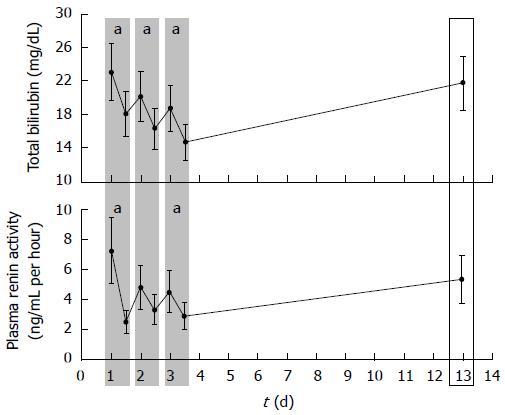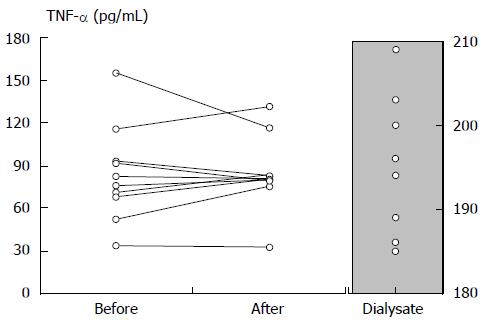Copyright
©2014 Baishideng Publishing Group Inc.
World J Gastroenterol. Jul 7, 2014; 20(25): 8011-8017
Published online Jul 7, 2014. doi: 10.3748/wjg.v20.i25.8011
Published online Jul 7, 2014. doi: 10.3748/wjg.v20.i25.8011
Figure 1 Changes in circulating levels of total bilirubin and plasma renin activity before and after each 7-h molecular adsorbent recirculating system session performed on 10 patients with severe alcoholic hepatitis (gray shaded bars).
Ten days later there was a recovery of these levels although they were lower than before treatment (P = NS). aP < 0.05 vs before and after each molecular adsorbent recirculating system (MARS) session.
Figure 2 Tumor necrosis factor-α (TNF-α) levels before and after molecular adsorbent recirculating system treatment in patients with severe alcoholic hepatitis.
Although no significant decrease was observed in the circulating TNF-α, the dialysate was enriched with this cytokine, thus indicating that albumin dialysis is able to remove some substances related to the pathogenesis of the disease.
Figure 3 Cumulated survivals of the ten patients with severe alcoholic hepatitis treated with 3 consecutive 7-h molecular adsorbent recirculating system sessions.
Fifty percent of the patients were still alive 6 mo after treatment, and 40 percent survived 20 mo.
- Citation: Parés A, Mas A. Extracorporeal liver support in severe alcoholic hepatitis. World J Gastroenterol 2014; 20(25): 8011-8017
- URL: https://www.wjgnet.com/1007-9327/full/v20/i25/8011.htm
- DOI: https://dx.doi.org/10.3748/wjg.v20.i25.8011











